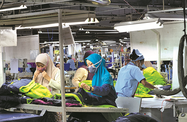Talk of a slowdown is rarely distanced from discussion of India’s current economic climate. However, carmakers and component manufacturers, who have flocked to the subcontinent since 1983, remain confident in the long-term economic health of the country.
Ahead of an expected second year of 5.4% GDP growth, 2013 accelerated into January with news that Maruti Suzuki had purchased land for its fourth plant, which will double total national production capacity to approximately 3m units annually. The new plant is expected to begin production of 750,000 units per year in 2017 and target export markets in the Middle East and Europe.
Maruti Suzuki – India’s first foreign manufacturer, which was set up 30 years ago in a joint venture with the government – has long held market dominance by sales. However, growing incomes across India saw an estimated 20m households enter the car-purchasing bracket between 1983 and 2008, which has piqued the interests of car manufacturers across the spectrum.
Today, India hosts three major automotive centres: in the north surrounding Delhi; Tamil Nadu in the south; and Gujarat in the west. These areas are home to a number of manufacturers, including 15 firms that produce passenger cars and multi-utility vehicles, two- and three-wheelers (16), tractors (14), commercial vehicles (nine) and engines (five). Combined, these are expected to boost India’s share of global auto exports from 2006’s low base of 0.3% to less than 10%, yet equivalent to an aggregate $35bn in earnings. Domestically, growth is targeted at 10% of national GDP and 30-35% of industrial GDP.
India is ranked the world’s second-largest market for two-wheelers, third for small cars and fifth for commercial vehicles. The domestic market mirrors these trends. The industry produced 20.33m vehicles in 2011-12, with two-wheelers representing 76% of the market; passenger vehicles, 15%; and commercial vehicles, 4%. It was also the first year in India’s history that the number of car sales crossed 2m in a financial year.
These production figures support research published by Espirito Santo Securities (ESS) this year that the Indian auto and auto components industry is expected to surpass China’s growth rate in the next decade. The Component Manufacturers Association of India is predicting annual sector growth at 12% through to 2021, although the industry could comfortably beat this rate with the growth of both first-time and second-hand car markets.
With automotive sales growth tied to per-capita income, ESS research predicts that India’s consumption trends are just seven years behind China. India has now reached per-capita income of $3500 on a purchasing power parity basis; China stood at the same in 2003-04, after which car sales recorded consistent growth of not less than 30%.
Indications are that India may yet hit that stride in the coming years. Poor public transport, coupled with the increasing availability of finance, rapid urbanisation growth rates, improved national roads infrastructure, rising family income and the development of a second-hand car market, are key to the increasing confidence of manufacturers in the sector. First-time car buyers are also getting younger, reportedly dropping from 39 in 2000 to 33 in 2010.
However, the growth rate in car sales is expected to reach a nine-year low, largely due to high interest rates, slow economic expansion and more recently a reduction in subsidies of diesel, which has seen pump prices jump Rp5 ($0.09) per litre.
Domestic sales in the last three quarters of 2012 grew 4.5% y-o-y, with the sale of passenger vehicles up 8.37% in the same period. Although utility vehicle sales grew 59.1%, the overall commercial vehicles segment registered marginal growth of 0.7%. This was led by light commercial vehicles (15.6%), whereas medium and heavy commercial vehicle sales dropped 19.1%. Responding to wider global economic environments outside India, automobile exports saw exports fall 2.9% in the same period.
However, short-term economic potholes have done little to dent confidence or slow the sector. Maruti currently contributes at least 30% of Suzuki’s pre-tax profit and the firm expects Indian production to eclipse its Japan home market volumes of 1.02m units in the near future. Meanwhile, Ford India has followed them into Gujarat, hiring 5000 for an SUV plant that is expected to begin operations in 2014.
India’s automobile manufacturers continue to put their faith in the sector’s potential, as evidenced by planned expansion efforts. While growth may be slowing in some segments of the industry, the overall sector looks set to meet expectations in the coming years.

